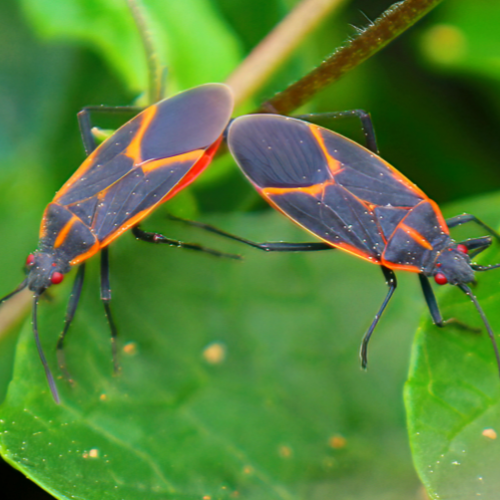Boxelder Bug
Introduction to
Boxelder bugs are a common pest found throughout North America. These insects are particularly notorious for invading homes during the fall, seeking warmth and shelter. This guide provides a detailed overview of boxelder bugs, including how to recognize them, understand their biology, their habits, prevention tips, and professional pest control options.
Recognition
Boxelder bugs are easily recognizable by their distinctive markings and size. Adults are about half an inch long and have a dark brown or black body with red or orange lines running along the thorax and wings. Their wings lay flat over their bodies, forming an X shape. Nymphs, or immature boxelder bugs, are bright red and lack wings, but they share the same elongated body shape as the adults. These insects are commonly found on boxelder trees, maples, and ash trees, where they feed on the seeds, leaves, and twigs.
Biology
Boxelder bugs belong to the family Rhopalidae and are true bugs. They undergo incomplete metamorphosis, transitioning from egg to nymph to adult. Females lay clusters of eggs on the leaves, bark, and stones around host trees. The eggs hatch in about a week, and nymphs undergo several molts before reaching adulthood in about two months. Boxelder bugs primarily feed on plant material, using their piercing-sucking mouthparts to extract juices. They do not cause significant harm to their host plants, but their presence can be a nuisance.
Habits
Boxelder bugs are most active during the warmer months, feeding and reproducing on host trees. As temperatures drop in the fall, they seek shelter in buildings, often congregating in large numbers on the sunny sides of houses. Once inside, they can be found in wall voids, attics, and around windows. Although they do not bite, sting, or cause structural damage, their presence can be distressing, and they can leave red stains on walls, curtains, and furniture if crushed.
Prevention
Preventing a boxelder bug infestation begins with exclusion. Seal cracks and gaps around doors, windows, and foundations to prevent their entry. Repair or replace damaged screens on doors and windows. Reduce their presence by removing boxelder trees, especially female trees that produce seeds, or by maintaining a distance between trees and buildings. Additionally, vacuuming up any bugs found indoors and disposing of them can help manage their numbers. Outdoor chemical treatments can be applied to host trees in the late spring and early summer to reduce populations.
Professional
When boxelder bugs become a persistent problem, professional pest control services can offer effective solutions. STL Pest Control provides thorough inspections and tailored treatment plans to address boxelder bug infestations. Their methods include exterior treatments to prevent entry and interior treatments to eliminate any existing bugs. Professional services ensure that the infestation is handled safely and efficiently, minimizing the inconvenience and potential damage caused by these pests.



Our Office









